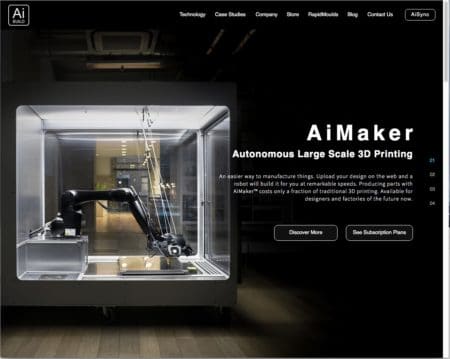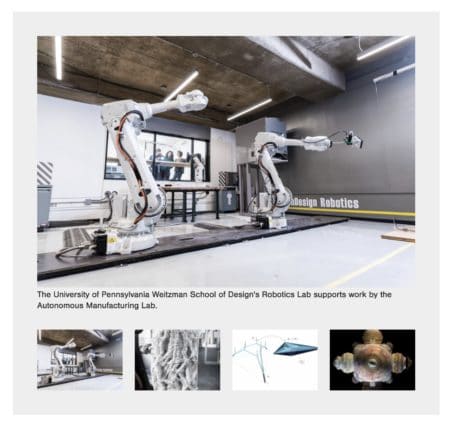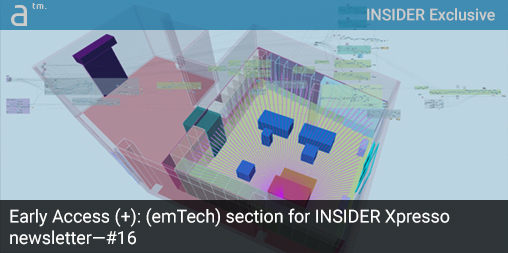Xpresso is the new ToshLetter
FOR LONG TERM READERS, you may recall our ToshLetter PDF newsletter from the last decade. Xpresso is the heir apparent to that newsletter, which in hindsight we realize now was actually a sensation that we failed to recognize.
Xpresso is purposely designed to focus on emerging technologies in the CAD industries, whereas ToshLetter was aimed more broadly. We have been learning that Xpresso readers are quite interested in general topics as well, and not just emTech. Duly noted, we continue to evolve the format for this newsletter. Let’s dig in.
The Top Ten Must-Reads
I’ve combed the Internet to find the most interesting, compelling, or controversial stories about the AEC and manufacturing industries, and the social and emerging technological forces at play on both:
1 – Practicing Architecture in a Pandemic, is the title of this New York Times piece featuring Elizabeth Diller of renowned architecture firm Diller Scofidio + Renfro. She discusses the challenges facing her practice—one where “usually we work, we draw, we look in each other’s eyes, we argue, we throw things around the room, we make models and break them apart, and somehow stuff gets made…” but unable to meet in groups the struggle is real and felt. (The New York Times)
What’s the potential upside in this struggle? Diller Scofidio + Renfro is the selected architecture firm tasked with designing the new School of Architecture and Planning (SA+P) at MIT. The lessons learned from the pandemic may pivot the firm’s approach to how best to develop schools of architecture for a future pandemic.
2 – How should L.A. be redesigned for coronavirus? Are doorknobs out? We asked the experts. (Los Angeles Times)
The crux of the problem? “If you take the great architectural inventions of the 20th century: the airport, the high-rise, the freeway — those are the things that are challenged the most right now,” says Brett Steele, dean of UCLA’s School of the Arts and Architecture. “They have great density or they promise movement at high speeds. Those are exactly the things that sit at the crux of the crisis we are going through.”
Is there a conundrum? Speed is tied to economics and competition. It is hard to imagine the forces of speed not acting on the future development of cities and architecture. Though Rem Koolhaus has recently made the point about airports now doing their best to essentially make the path to your plane as circuitous as possible in the name of commerce. And then there is “density”—a new negative for pandemics but a hero for sustainability and the environment. (see: Architosh, “Firm Profile: BOGDAN & VAN BROECK—The Ecology of Densification,” 11 Aug 2015). In short, the architecture and cities of the future will need to balance the demands of speed (economics) and density (ecology) in new ways that mitigate their intrinsic negative attributes in light of pandemics. Certainly, smart cities tech and planning will have much to say about this. (see next story)
3 – How Smart City Planning Could Slow Future Pandemics. This thoughtful piece suggests that the Covid-19 is a chance for us to re-evaluate the ways in which cities are built, maintained, and lived in. (Wired)
What’s the low-down? We are on an urban planet. “The global economy is living and dying by what happens in cities. Sadly, most if not many were not designed or built with transmissible infectious disease—or human health—front of mind.”
4 – AI Transforming The Construction Industry. This piece in Forbes discusses the ways artificial intelligence is being adopted in one of the world’s oldest professions. (Forbes)
What is essential in this story? The construction industry is realizing that for small-scale projects humans may be capable of managing complicated schedules and processes, but for large, multi-year projects, the kind that overwhelms humans when too many moving parts, delays, plan changes and unexpected delays through projects into chaos, artificial intelligence (AI) assistance may just be the what doctor ordered to bring control back into the process.
5 – Architecture and Design has a piece on 6 practices bringing AI into architecture. I wanted to share this piece because it brought up Stanislas Chaillou’s research in AI and architecture again. We covered Chaillou’s Harvard GSD thesis in AI in a past issue of Xpress. (A&D)

AI Build is a London-based startup focused on AI-based digital and autonomous construction systems. (Image: screenshot of AI Build website)
And other finds? While this article also touched the use of emerging technologies (emTech) in firms like 3XN and its research division GXN (we discussed this firm in a previous Xpresso newsletter) it brought to my attention AI Build, a London-based startup producing autonomous construction systems. Says the article above, recently, they teamed up with ARUP Engineers to create the Daedalus Pavilion, a 5×5 meter latticework.
6 – Exploring Potentials of AI in Revolutionizing Architecture. This short article, by a leading publication focused on AI, Big Data, and analytics, offers the more prevailing view that architecture, while highly subject to the forces of automation, is less likely to be radically eliminated by AI. Oxford researchers on AI suggest, “…even with AI coming into the scene, the essential value of architects as professionals who can understand and evaluate a problem and synthesize unique and insightful solutions will likely remain unchallenged.” (Analytics Insight)
Will this thesis on AI in architecture hold? It is hard to imagine the disappearance of architects at the scale expressed by Sebastian Errazuriz—who we mention below. However, one when one looks at technologies like GenDes—also discussed below—it is difficult to argue the virtues of powerful tools like Sidewalk Labs’ GenDes and similar parametric, AI, infused tools and tackling large problems with vast parameters that can all be “weighted” according to an architect, owner, user-community algorithm. (see Computational Design Tools News, below)
7 – Rise of artificial intelligence means architects are “doomed” says Sebastian Errazuriz, who is a New York-based designer who warned that 90 percent of architects will lose their jobs in the end to AI. The prediction is actually from last Fall and was made on his Instagram account. Stating, “It’s almost impossible for you to compete” with algorithms…adding: “The thing is you’re not that special.” (Dezeen)
Delusion or Reality? Most studies in AI’s impact suggest that the field of architecture is one of the most insular from suffering from automation. Errazuriz has a history of making noise, but is it signal? His Instagram post showcased an animation of a parametric tool developed by Wallgren Arkitekter and BOX Bygg. The tool in question is Finch, which was slated to arrive in 2020 as a plugin to the visual programming tool Grasshopper and Rhino. It still appears to be in beta. Will architects really be replaced by artificial intelligence? That was a question we delved into with six experts on the subject in the first issue of Xpresso, (see: “Pondering the Impact of AI (artificial intelligence in AEC Industries—the Wide View,” Xpresso #01).
8 – U Penn students control robots remotely to complete semester work. At the University of Pennsylvania, Weitzman School of Design, students in Ezio Blasetti’s course, Computational Composite Form Computational Fiber Robotic fabrication seminar completed their work remotely due to the pandemic. (Archinect)

U Penn’s Weitzman School of Design’s Robotics Lab supports work by the Autonomous Manufacturing Lab. (Image: screenshot of U. Penn. Graduate Architecture resources page.)
A sign of the future? A quick adaption and the help of remote access tools provided by Dropbox saved the day. Lessons? For sure, remote access technology is more important than ever and so are tools that allow remote control of laboratory equipment like robotic arms and 3D printers.
9 – Engineering Considerations for Your Return to Work, is a technical report from CannonDesign, one of the US’s top architecture firms. This is a fantastic short report that serves as an excellent service message to all employers and employees. (Cannon Design)
10 – The US is gaining a $12 billion new chip plant that may signal a shift in high-tech ITC manufacturing in America. Taiwan Semiconductor Manufacturing Co. (aka: TSMC) is not only the world’s largest chipmaker but one of just three in the world that can produce the most advanced CPUs and other chips at a fab process 10 nanometers or smaller. (MIT Technology Review)
What’s does this mean? TSMC makes chips for Apple and Huawei, two big rivals in smartphones globally. But the latter is on a US Department of Commerce list of companies banned from receiving technology from US companies without a special license. While this story is focused on US-China relations and tensions over IP, the presence of an American TSMC plant may prove pivotal for Apple which may wish to exercise tighter control over future A-series chips. However, that may take years as the American planned plant is expected to make 5-nanometer chips first, not the cutting-edge 3-nanometer and smaller.
Computational Design Tool News
Sidewalk Labs, an Alphabet subsidiary focused on urban development and building showcased a generative design tool the company was developing last December (2019). That tool is discussed and showcased in the video and images below.

Sidewalk Labs has several new products that folks can “pilot” including its Generative Design tools (GenDes). (Image: screenshot of Sidewalk Labs’ website)
While Sidewalk Labs’ website still says the tool, called GenDes, is coming soon, they are taking people’s email, name, and other information for those expressing interest in GenDes.
After watching the video below, you may want to sign-up here, so you can possibly get an early chance to evaluate this type of design tool.
Rediscovering Flux: Lessons for generative design software. This article over at Parametric Monkey, discusses Flux’s history of software development. What makes it interesting is Paul Wintour’s smart observations about why various efforts at Flux failed, starting with its Flux Metro software project which focused on the city of Austin’s zoning code and visualized all the myriad data inside that code.
Further Commentary: At the time Flux Metro was around, I was highly involved with a Boston-Providence area startup (Simulicity) and the SIM team was quite intrigued by this big bet the Google startup was making.
As Wintour astutely notes, zoning codes are famously irregular, quirky, and also not machine-readable. This made Flux Metro not scalable. Flux would then pivot and come out with Flux apps and these two would fail. Now the company pivoted again in the digital twins direction with HelixRE. Read on here.
Construction emTech News
Advancing Automation in Construction. This company blog post by Brasfield & Gorrie discusses advancements in machine control automation in building site excavation.
So how does it work? Machine control users design models and GPS to position earthwork machinery. 3D models, AutoCAD files, and GPS data are fed into a piece of equipment.
This U.S. construction firm is raising buildings via drone. This Verizon corporate story discusses Birmingham, Ala-based Brasfield & Gorrie again, this time talking about the tech-forward construction company’s use of drone operations to improve their overall construction operations.
Digital twins to play a bigger role in post-pandemic construction. This ConstructionDive brief makes the point that with data intrinsic to a digital twin, architects could better plan for social distancing in both new and existing structures.
What is the impact? Digital twins are not simply BIM models loaded with data, but rather a collection of models and textural information all intelligently linked together to provide an up-to-date virtual twin of a physical asset. The digital twins market today is worth $3.8 billion but will rapidly increase to $36 billion by 2025. That’s a 9x fold increase!
What’s Cooking: Future Xpresso Features
One of our features coming up on Xpresso before it arrives on Architosh is on Autodesk-based firm, Stamhuis of the Netherlands. A retail specialist, Stamhuis designs and builds out entire stores in record times.
The company is innovative and constantly evaluating ways to streamline its processes, at both the design, manufacturer, and erection phases. To streamline their design workflows in Autodesk Revit, the company has recently adopted customized Dynamo scripts that build a design for a new store in minutes, one conforming to numerous programmatic requirements and design standards.
We look forward to sharing this story in Xpresso #17 in July.
Issue Index
I have mentioned the following companies and solutions in this issue (see above):
3XN – architecture design firm
Autodesk Revit – BIM software tool
Dynamo – visual scripting algorithms-aided design (AAD) tool
Finch – a next-gen generative design tool
GXN – 3XN’s digital research lab
GenDes – Sidewalk Labs’ parametric AI design tool
HelixRE – AECO digital data services company
Parametric Monkey – Australian based consultancy specializing in AAD and BIM
Sidewalk Labs – a digital data-driven design innovator
Simulicity – AECO digital data and “design expertise” services company
Closing Notes
This is the first Early Access+ report feature on the (emTech) section of the upcoming INSIDER Xpresso #16. Xpresso is our free monthly newsletter focused on emerging technologies in AEC and manufacturing industries.
Upcoming Bonus! In the near future, INSIDER Members will gain another exclusive: an exhaustive glossary and index to every release of our Xpresso newsletter. We will index all issues, all companies, all products and services, sources of knowledge and insight. In short, everything written about in Xpresso will be indexed.





Reader Comments
Comments for this story are closed